2025 Mini Countryman First Drive Review: Mini no more

CASCAIS, Portugal — Let’s cut straight to the issue of size. If the original Mini was a sporting beagle ready for the hunt, the reborn version that hit the world stage in 2001 may have been an English bulldog, albeit bred in Germany, its parents being the engineers and coffers of BMW. From there, the Mini brand has grown in size in regular increments, culminating with the 2025 Mini Countryman that’s the subject of this review.
The first Countryman that we first tested in 2011 was comparatively large for the brand, but was suitably mini by SUV standards. Its stocky proportions moved it well into the working dog class. And then the second-generation Mini Countryman debuted for the 2017 model year, gaining 8 inches in length and more than 5 inches of width over its predecessor. We described it as “still in keeping with the brand’s ethos from the very beginning when Alec Issigonis created a car that was microscopic on the outside but disproportionately spacious inside.” Nevertheless, it was starting too look a little husky, if you catch our drift.
Consider the 2025 Mini Countryman a mastiff, then.
Compared to the second-gen Countryman it replaces (which, as we already pointed out was much larger than the first edition), the new version is 5.1 inches longer, 2.4 inches taller and 0.8 inch wider. This translates into additional interior space for passengers and cargo, but adds an awful lot of visual and physical girth to something wearing a badge that literally calls out a diminutive size. The proportions are well considered, but parked next to the old car, the new Countryman sticks out like a sore thumb. Literally, like one that’s swollen post-accidental-hammer strike.
When the full Countryman model lineup is available Stateside, a base model may well be included, but at least for the start of 2025 production the lineup will start with an S edition for $39,895 that will have 241 horsepower and 295 pound-feet of torque. We’re not driving that today. Instead, the subject of this review will be the only other gas-powered Countryman: the high-performance John Cooper Works edition or JCW.
The new Countryman JCW starts at $47,895 and is powered by a 2.0-liter turbocharged four-cylinder that spins out 312 ponies (up from 301) and 295 pound-feet of torque (unfortunately down from 331) to all four tires through a seven-speed dual-clutch gearbox and Mini’s ALL4 all-wheel-drive system. It’ll hit 60 in around 5.4 seconds, and with its fat torque curve, the engine feels especially powerful in the middle range where most driving takes place. Still, size pays a penalty: The previous Countryman JCW hit 60 in 4.9 seconds.
The quick shifts that the seven-speed gearbox can fire off are appreciated, and its tuning feels equally adept at low throttle as high. Clicks of the paddle shifters to the left and right of the wheel equal satisfyingly quick gear changes, but the transmission’s default tuning is generally appropriate, depending on what mode the vehicle is in. The Countryman JCW’s steering is also good, if (as the theme continues) tuned surprisingly aggressively in sporty drive modes. The wheel is very thick, and there’s plenty of feedback on the twisty road surfaces experienced here in Portugal, indicating how much grip remained at all four corners. It’s also good at maintaining the straight ahead with little wandering.
We said “drive modes,” but they are now known as Mini Experience Modes that go beyond the usual adjustments to steering, throttle response, etc. to include changes to interior ambience and powertrain noises. These are similar in concept to what you’ll find in various BMWs, but have unique-to-Mini modes/names. Green acts as an eco-friendly mode with graphics that change from a mint hummingbird to a pink panther depending on how aggressive the driver is with the throttle, Timeless is characterized by seemingly relaxed settings and a beige palette. Go Kart tuning turns everything black and red while maximizing responsiveness. The default mode is called Core, and it’s where we generally preferred to leave the car.
Also brought over from BMW is a Boost Mode activated by the left (downshift) paddle on the steering wheel that immediately puts all modes into their most aggressive settings for 10 second bursts. This is a much-appreciated feature since it means the super-agro Go Kart mode doesn’t often feel necessary. There’s a noticeable change in sound between the modes, aural evidence of Mini’s use of the speakers to pump up the internal combustion jams in the cabin. We even heard occasional pops from the exhaust that we’re pretty certain were digitally generated.
There’s also a Trail Mode. We do not expect any actual Mini Countryman John Cooper Works owners to require a Trail Mode, but if they were to find themselves further off the beaten path than is advisable, readouts for the car’s various lateral angles could be helpful as it hypothetically clambers over obstacles. Ground clearance is pumped up to 8 inches, a useful increase from the old model’s 6.5 inches.
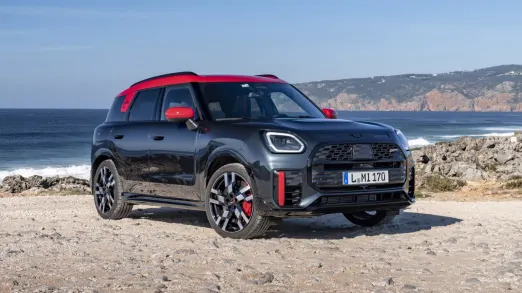
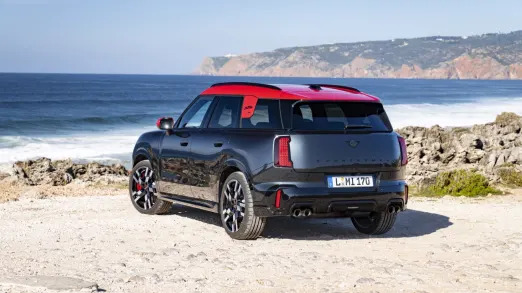
Also larger than before are the wheels and tires, which, along with the additional width (our test car was wearing 245-width rubber), means the new Countryman feels a few notches less nimble and athletic than before, but ultimately has comparatively high levels of grip. And this brings us to one serious demerit. On the heavily scarred roads in and around the Portugal coast, the stiff ride of the Countryman in John Cooper Works trim was very pronounced. Despite an adaptive suspension, heads were bouncing around like bobbleheads glued to the dashboard as we dodged joggers, cyclists and pedestrians on tight bends and roads with cobblestone curbing.
In a place with smooth road surfaces, the Countryman JCW will likely feel firm but generally acceptable. On roads pockmarked by potholes and various other fractures … well, fortunately the seats are quite comfortable with good padding and reasonable bolstering.
We weren’t able to test any other Countryman models with internal combustion powertrains, so we can’t say with certainty whether lower and less-sporty trim levels will benefit from less punishing suspension tuning. Smaller wheels than the 20-inchers fitted to our test car (19-inch wheels come standard) would likely result in a more refined ride with less stutter and jostle. Unfortunately, all of the suspension’s adaptive nature takes place automatically, so despite all those drive settings, there’s no way for the driver to specifically dial up a bronco less keen to buck them out of the saddle.
Also tuned very aggressively are the JCW’s optional high-performance brakes. Due to their hyper-sensitive initial bite, several times we applied more force than we meant to or was warranted to slow the car. We got more attuned as time with the car went on, so owners will likely adjust. A test car without the optional braking package wasn’t available to test.
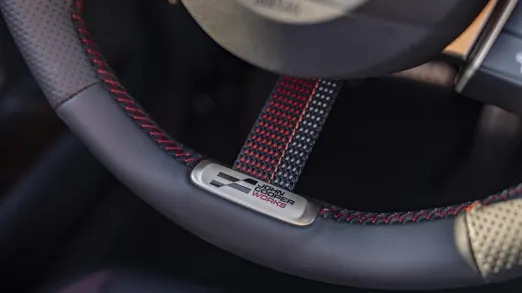
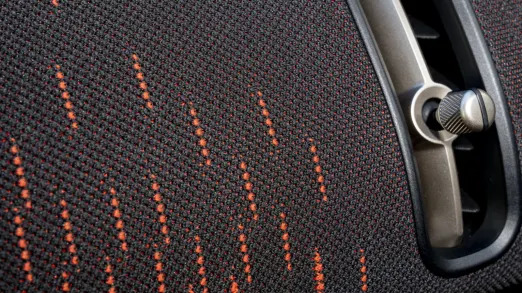
One benefit in creating this Maximum Mini is that there’s good space in the bright and airy cabin. The vehicles we drove were Euro-spec and some final numbers for U.S. models may come in later, but there’s a general feeling of spaciousness inside for both front and rear passengers. A 6-foot driver was able to sit behind their seating position up front without knees touching. Arms and leg angles also felt comfortable. Cargo room is up, coming in at nearly 25 cu-ft with the rear seat in place (up from 17.6) and over 56 cu-ft with the setback folded (up from 47.6). That volume is basically equal to the mechanically related BMW X1, giving both two of the largest cargo areas in the subcompact luxury SUV segment.
Unlike past Mini models, you won’t find any chrome inside the new Countryman, or actually any other upcoming Mini, either. Instead, the interior is fashioned with a slew of textiles (some from recycled and repurposed materials) and faux leathers. It’s a much more modern look than the fun and funky Mini models of the recent past. Various themes carry names like Essential, Classic and Favored, with the JCW’s black-and-red motif standing out as the most aggressive and, arguably, least visually interesting. Appealing blue, green and tan shades with distinctive lighting under cloth coverings featured in other themes offer a more soothing look and feel to the Countryman’s cabin, with a few contrasting bits to offer visual pizzaz.
A large circular OLED center screen — the first in production in this shape — dominates the dashboard. It’s a touchscreen, and Mini has completely moved away from any sort of joystick or knob control with its latest operating system, known internally as Mini OS 9. It’s easy to use and doesn’t rely on menu structures that get too deep. Occupants can also use the so-called Intelligent Personal Assistant to talk directly to the car, and the virtual assistant named Spike (shaped sort of like an anime puppy) managed to understand certain commands when greeted with a “Hey Mini” verbal cue. Owners can likewise download a Mini application to their smartphones, which works as a mobile key to access the vehicle and can set service appointments. Additional apps can be downloaded to the vehicle, including those for subscription-based audio services. We downloaded Spotify and logged in without issue.
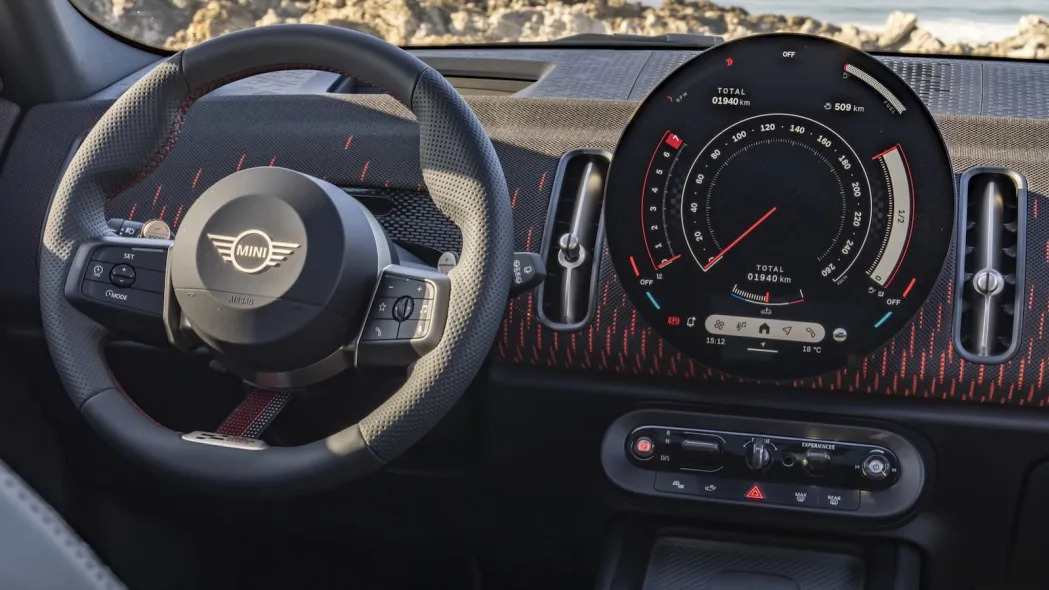
Under the central circle sits a binnacle with four very Mini controls. A key-like switch in the center is twisted to turn the car off and on. A horizontal toggle operates the transmission (up for reverse, down for drive) with a Park/parking brake button next to it, while another toggle goes through all those “Experience” modes. There’s then a volume knob that doubles as a left-right track selector. Controls on the steering wheel, including those for cruise control and infotainment, are identical in functionality and layout as what you’ll find in the newest BMWs.
We have legitimate gripes about the expansive size of the new 2025 Mini Countryman, but in the real world, the designers’ implementation of growth hormones has resulted in a vehicle that’s probably better suited to everyday life in the United States. Whether it fits neatly into the brand’s positioning likely means a lot more to us than to potential buyers. And it’s those buyers who will decide if this steroidal “Mini” is a success or failure.
Longtime brand purists may turn their noses in disgust, but this latest Mini Countryman — even in its most aggressive John Cooper Works trim — is a small crossover that’s easier to live with and drive every day than the version it replaces. The fact that this Countryman is roughly the same size as the BMW X1 and X2 pair (all three share the same platform) proves size is relative. Nobody would call either BMW large, but then again, a BMW is not a Mini. Regardless, we’re comfortable predicting that this big Mini, contradictions aside, will win over buyers.
As for this John Cooper Works version, it misses the mark. It’s quick and handles curvy roads very well at speeds that aren’t often experienced. But aren’t the drivers who will appreciate such traits also the ones most likely to look at this Countryman as a deviation from its breeding stock? For everyone else, the JCW will be too hardcore for daily-driving duties. A beagle is not a mastiff, and buyers looking for one may see the other as fun or even fashionable, but not really for them. Hardcore performance and everyday practicality sometimes mix well together, but in this case, we’d wait for less hardcore Mini Countryman models if shopping in the segment.



